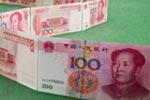Slowing M2 growth 'within expectations'
Updated: 2011-09-13 09:48
By Wang Xiaotian (China Daily)
|
|||||||||||
|
A lending company in Nanjing, Jiangsu province. Business is booming for lending companies from tightened liquidity, but the central bank said current liquidity levels are "appropriate". [Photo / China Daily] |
BEIJING - The Chinese central bank said on Sept 12 that the slower pace of money supply growth in August was within expectations and the overall money supply was in line with current steady economic growth.
In a statement on its website, a spokesman for the central bank, the People's Bank of China (PBOC), said some data for August didn't fully reflect the actual total money supply because of diversifying financial tools and lenders' increasing off-balance-sheet assets.
"We are considering widening the measurement and developing an 'M2+' concept to better reflect the newest developments in financial markets," the statement said.
M2, a broad measure of money supply that covers cash in circulation and all deposits, increased 13.5 percent year-on-year as of the end of August, the slowest growth rate in six years, according to data released by the PBOC on Sept11. The growth rate was 1.2 percentage points lower than in July and 5.7 percentage points lower than in the same period last year.
"We believe the major cause of the sharp decline in M2 growth was a significant statistical revision of the accounting standards for deposits and loans," said Li Wei, an economist with Standard Chartered PLC. For instance, about 50 percent of the reported M2 growth for March was not due to new loans and foreign exchange purchases - the factors that policymakers and market participants usually watch, he said.
"That means comparing official M2 growth with the 16 percent PBOC target that was set under the old method is now impossible."
Off-balance-sheet activity in the banking sector, as well as corporate on-lending, have made what was traditionally the most important leading indicator of the economy, bank lending, less reliable, said Wang Tao, head of China economic research at UBS Securities Co Ltd.
"The central bank and bank regulators have recently attempted to tighten supervision of off-balance-sheet lending, which could make actual liquidity in the economy tighter in the remainder of the year, even as M2 growth recovers," said Wang.
Appropriate liquidity
"We will continue to make stabilizing prices a priority as inflation remains white hot," said the central bank in the statement. It added that current liquidity levels are "appropriate" given still fast loan growth and the overall scale of financing.
New yuan lending reached 548.5 billion yuan ($85.8 billion) in August, up 9.3 billion yuan year-on-year and up 55.9 billion yuan from July.
E Yongjian, an economist with Bank of Communications Co Ltd, said the higher-than-expected loan figure in August was attributable to the government's call to increase lending to small and medium-sized enterprises, which are most sensitive to rising costs and tighter liquidity.
From January to July, new financing stood at 8.3 trillion yuan, with loans accounting for 56.2 percent. "Other channels such as bonds and stocks also played important roles in financing," said the PBOC.
The current balance of economic growth and inflation suggests that some "selective" or "targeted" easing measures are likely in the coming months, said Huang Yiping, managing director and chief economist for emerging Asia in the investment banking division of Barclays Bank PLC.
"We would not rule out a reserve requirement ratio cut toward year-end. But we also do not expect any loosening of monetary policy in the near term in the form of rate cuts or across-the-board reductions" in the reserve ratio, he said.
Related Stories
More loans offered to help SMEs 2011-09-12 09:15
New yuan loans hit 548.5b yuan in August 2011-09-12 09:05
China to re-book some local govt loans 2011-08-15 11:47
Bank loans tougher for first-home buyers 2011-08-09 13:56
- Chinese yuan appreciation 'will remain gradual'
- M2 growth slows down
- Job seekers' prospects bright for Q4
- Inflation causes split opinion
- Yuan useful in corporations' overseas deals
- Local debts controllable amid tightening regulations
- New yuan loans hit 548.5b yuan in August
- Price stability still top priority














